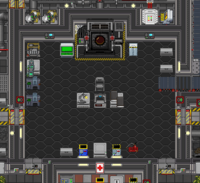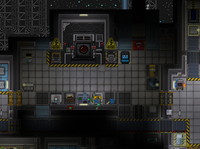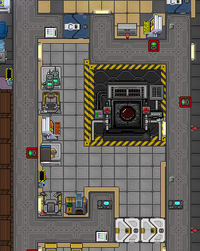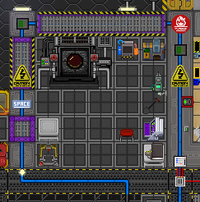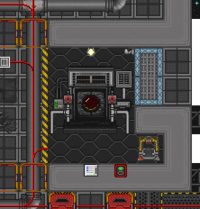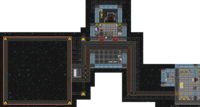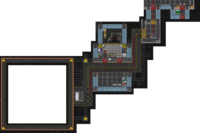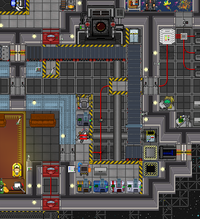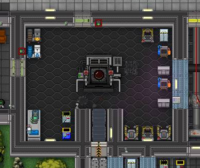Ore Processing
| Ore Processing | |
| Location | |
|---|---|
|
Metallurgist's paradise. | |
|
Everybody | |
Turning raw ores or metal bars into weird, fancy alloys is possible with the help of an arc smelter. The public one (and the main subject of this guide) is located above the cargo bay and public market. The mining department has access to another arc smelter tucked away in the derelict Mining Outpost.
| Ore Processing | |
| Location | |
|---|---|
|
Metallurgist's paradise. | |
|
Everybody | |
Turning raw ores or metal bars into weird, fancy alloys is possible with the help of an arc smelter. The public one (and the main subject of this guide) is located next to the cargo bay and above the warehouse. The mining department has access to another arc smelter tucked away in the derelict Mining Outpost.
| Ore Processing | |
| Location | |
|---|---|
|
Metallurgist's paradise. | |
|
Everybody | |
Turning raw ores or metal bars into weird, fancy alloys is possible with the help of an arc smelter. The mining department has access to one above their department and another smelter tucked away in the Mining Outpost.
| Ore Processing | |
| Location | |
|---|---|
|
Metallurgist's paradise. | |
|
Everybody | |
Turning raw ores or metal bars into weird, fancy alloys is possible with the help of an arc smelter. The "public" one (and the main subject of this guide) is tucked below the engine and the cargo bay. The mining department has access another arc smelter tucked away in the Mining Outpost.
| Ore Processing | |
| Location | |
|---|---|
|
Metallurgist's paradise. | |
|
Everybody | |
Turning raw ores or metal bars into weird, fancy alloys is possible with the help of an arc smelter. The public one (and the main subject of this guide) is tucked away in the maintenance tunnel behind the warehouse. The Miners have their own "private" arc smelter in their own department as well as another one tucked away in the Mining Outpost.
| Ore Processing | |
| Location | |
|---|---|
|
Metallurgist's paradise. | |
Turning raw ores or metal bars into weird, fancy alloys is possible with the help of an arc smelter. The Miners have one in their little department outside of Engineering, as well as another arc smelter tucked away in the Mining Outpost.
| Ore Processing | |
| Location | |
|---|---|
|
Metallurgist's paradise. | |
Turning raw ores or metal bars into weird, fancy alloys is possible with the help of an arc smelter. The Miners have one in their little area below Tool Storage, as well as, as always, another arc smelter tucked away in the Mining Outpost.
| Ore Processing | |
| Location | |
|---|---|
|
Metallurgist's paradise. | |
|
Everyone | |
Turning raw ores or metal bars into weird, fancy alloys is possible with the help of an arc smelter. The "public" one is in the Waste Plant, like some sort of recycling center. The Mining Department has one too, and there's another tucked away in some alcove in the Mining Outpost.
| Ore Processing | |
| Location | |
|---|---|
|
Metallurgist's paradise. | |
|
Everyone | |
Ore Processing is the fine art of turning raw ores or metal bars into weird, fancy alloys using the public arc smelter in the Refinery near Cargo and all its myriad doohickeys and thingamajigs.
| This page is under construction. The following information may be incomplete. Needs new uses for the new material system and any changes to the material properties |
So fucking metal!
The devices scattered around the room are as follows:
Arc Smelter: This giant contraption in the back of the room is where dreams are made. Simply insert a material into the smelter by clicking it with the desired material in your hand, then click the smelter with an empty hand to refine that material into an alloy bar, then click it again to retrieve the bar. Up to two materials can be loaded to make a combination alloy that combines the functionality of both materials (i.e. combining a metal and a crystal will have it be recognized as both metal and crystal). Note that every use of the smelter causes slag to build up inside of it which, if not removed, will decrease the quality of each successive alloy and cause smoke to billow out of the smelter until it's fixed. Remove slag by clicking the smelter with the slag shovel. Most compatible materials are listed here, though you can also use obscure things like the removed slag, gold or even human flesh with a willing donor. Experiment!
Material Processor:The rectangular-looking thing with two little horizontal claws. This is where you can insert ores, gems, and other various raw materials, and get ingots, blocks, and clumps of processed materials for use in the smelter or nano-fab.
Nano-Fabricator: The thing with the 2 little upright limbs. This is where you insert your alloy bars to make stuff. Most schematics require either metal alloys, fabrics, rubber, leather or crystals. A single bar can be made to fill all needs.
Material analyzer: The hand-held devices on the table next to the general manufacturer can scan and tell you all sorts of info about a material such as its hardness, electric conductivity, etc. You can use it on most materials as well as most things made with the smelter and fabricators.
General Manufacturer: These are found all over the station, really. As you'd expect from the name they're supposed to be used for producing general objects, but in Ore Processing it's more for material storage so people don't dump a huge mess of materials all over the room. Comes with a couple bars worth of mauxite, pharosium and molitz to get you started.
Properties
The material analyzer spits out a general description of the material and short list of properties and their specific numeric values.
Not all of these entries may be correct, be warned! If anyone has corrections to make, please do so!
| Property | Explanation | Notes |
|---|---|---|
| Radioactivity | How much radiation the material puts off. The more radiation it gives off, the more radiation damage you'll get | Standing on something made of radioactive material or (obviously) wearing it will apply radiation to you. |
| Electrical conductivity | How well electricity passes through the material. | You'll usually see conductive materials in wires. |
| Instability | How likely the material is to break, safely or catastrophically, when struck by a regular attack. | Erebite is known for being very unstable. |
| Hardness | How much damage the material does if you whack someone with it. | Works wonderfully on powerful melee weapons like fire extinguishers and toolboxes. |
| Toughness | How much melee damage is negated by the material when worn, such as from blunt objects and thrown items. | This is only if you're struck in the place where the worn material is; body armor alone won't do much if the attacker goes for your face instead. |
| Permeability | How well the material handles most chemicals. The lower the value is, the less likely it is that chems will reach you if splashed on you. | Biosuits have this really low. |
| Transparency | How see-through the material is. | Useless, but nonetheless neat. |
| Unique properties | Notes whether or not the material in question has anything special about it that doesn't fit under the other entries. This doesn't appear at all if there are no specialties to speak of. |
These can range from teleporting you randomly to color-shifting and so on. Experiment to see what does what! |
The Nano-Fabricator
At the top of the interface, there are 3 tabs.
- Blueprints: A list of items the fabricator can make
- Materials: This is where you can see all the components and supplies that are in the machine, available for your arts and crafts
- Setting: Not much to it, but you can set it to automatically store crafted items into the Materials tab. This is useful when making components for more complex items.
At the Nano-Fabricator you can make a lot of that cewl stuff.
| Product | Category | Requirements | Description |
|---|---|---|---|
| Spear | Weapons | (3) Metal (1) Arrowhead |
A simple spear with long reach. (This is very experimental and likely buggy) |
| Arrow | Weapons | (1) Arrowhead (1) Metal |
A simple arrow used as ammunition for bows. Can be poisoned. |
| Bow | Weapons | (3) Metal or Organic | A simple bow. (This is also very experimental and likely buggy) |
| Quiver | Weapons | (2) Cloth or Rubber | A quiver for arrows. Goes on your back. |
| Glasses | Clothing | (1) Crystal | A pair of non-corrective glasses. |
| Jumpsuit | Clothing | (3) Cloth or Organic | A custom made jumpsuit. Has no special properties. |
| Insulating gloves | Clothing | (2) Cloth or Organic | Custom insulating gloves. Inherits thermally and electrically insulating properties. |
| Armored gloves | Clothing | (2) Cloth or Organic | Custom armored gloves. Inherits physical properties like toughness and hardness. |
| Flashlight | Lights | (1) Metal (1) Lens |
A simple flashlight. Light color is affected by lens color. |
| 5 Light tubes | Lights | (1) Metal (1) Lens |
5 replacement light tubes. Lens color affects light color. |
| 5 Light bulbs | Lights | (1) Metal (1) Lens |
5 replacement light bulbs. Lens color affects light color. |
| 5 Tripod bulbs | Lights | (1) Metal (1) Lens |
5 replacement tripod light bulbs. Lens color affects light color. |
| Material Sheets (10) | Tools | (1) Metal or Crystal | Ten sheets for construction purposes. |
| Small energy cell | Tools | (2) Energy | A custom small power cell used in energy weapons. The more conductive the material used, the higher the capacity. Self-recharging cells are possible, though they will typically charge very slowly. |
| Large energy cell | Tools | (4) Energy | A custom power cell, like those used in APCs and Cyborgs. As with small cells, higher conductivity creates higher capacity cells, and self-recharging cells can be crafted. |
| Small Coil | Components | (1) Metal | A small coil used in various objects. |
| Large Coil | Components | (2) Metal | A large coil used in various objects. Add it here if you discover one. |
| Arrowhead | Components | (1) Metal or Crystal | An Arrowhead that can be used for arrows or in other objects. |
| Lens | Components | (1) Crystal | A Lens used as a component in various objects, such as the nano-fab bulbs and the antique laser gun. |
| Gears | Components | (1) Metal | Some gears used as parts in various objects. |
| Tripod | Components | (1) Metal | A tripod. Like the ones at the Space Pod beacons. |
| Armor plates | Components | (1) Metal | Armor plates used in various objects. Pod armor or mayby body armor. Add it here if you discover it. |
| Instrument body | Miscellaneous | (4) Material | The body of an instrument. |
| Instrument neck | Miscellaneous | (3) Material | The neck of an instrument. |
| Instrument mouthpiece | Miscellaneous | (2) Material | The mouthpiece of an instrument. |
| Instrument bell | Miscellaneous | (4) Metal or Crystal | The bell of an instrument. Not an actual bell. |
| Instrument bag | Miscellaneous | (4) Cloth or Organic | The bag of an instrument. |
| Instrument rod | Miscellaneous | (3) Metal or Crystal | A plain old hollowed out rod. |
| Infusion | Refining | (1) Chemical, (10) Unprocessed Material, (1) Starstone | Whatever chemical you infuse the materials with gains some of the properties of that chemical. CFL3-infused things are orange and set people on fire, pizza-infused materials look like pizza and are edible, things like that. |
| Space Suit Set | Clothing | (3) Cloth or Organic or Rubber, (3) Metal, (2) Crystal | A space suit and helmet set, very much like the ones in EVA |
Great! So what can I make with all that stuff?
You can attach instrument pieces to each other in an attempt to make an actual instrument.
Small coils and lenses can be used in the construction of the antique laser gun, though as of yet large coils have no use.
Tripods and their respective bulbs can be used to make standalone light fixtures. They also double as a handy barricade.
This is most likely nowhere near close to the complete list of things you can make, so add more things here as you find them!
So where do I get all the stuff I need?
| This page is outdated. The following information may no longer be correct. You can help by updating incorrect information. |
Procuring the right materials can be a bit luck-based. Sometimes the Quartermaster will get special materials from trades, and the Merchants that come by shuttle can also have some goods. In most rounds however you'll be relying on the Miners, whom you should yell at regularly to bring materials to the smelter since they're literally just down the hall from Ore Processing.
As for what materials you actually want, it really depends on what you're making and why. Here are some baselines:
- Floors, walls, grilles and the like? Make metal sheets out of something with a high resistance to explosions. These can't (normally) be destroyed with melee or bullets, so explosives are the only thing you need to worry about.
- Windows? Stack on protection from explosions and bullets. It's not hard for people to find a Screwdriver and Crowbar to displace them with, so firefights and explosions should be your priority.
- Note that you can produce reinforced alloy glass with regular metal rods. You don't need to go out of your way for exotic metal rods if you don't want to (though it does help).
- Jumpsuits? These will always need at least one piece of fibrilith/fabric (they're counted as the same thing) per construct, so bother Hydroponics/the Head of Personnel/the Miners for some. Human flesh is an acceptable substitute if someone suicided into the smelter.
All of this is, of course, subject to change depending on your objective and motives. You'll have to discover suitable materials for yourself, but after that it's all up to your imagination.
Alright, I got all that. Now how do I become indestructible?
Indeed, no crafting system is without a few advanced tricks. Here are some things to know:
- When you combine two materials, their stats average out. Let's say one material had a Hardness of 3 and another had 7; if you mixed them, the combined alloy would have a Hardness of 5.
- Merged materials will take on a mix-and-match name of whatever you put in, starting with the name of the first material and ending with the second. Additives will have their full name prefixed before the alloy name.
- If you're clever with the material order, you can cram all sorts of things into an alloy and then revert it to a base name. Make a jumpsuit out of starstone but prefix it with slag, no one can tell the difference without the Material analyzer! A very devious yet underused trick.
- Once a material is smelted into an alloy bar, that bar will keep the material's typing and quirks forever regardless of how many reforges it goes through. You could fuse whatever you want into a telecrystal and it would always have its spastic warping properties, you could pump a hundred ultra-dense uqill into fibrilith and it would still be considered a fabric, etc.
- This does not work with additives however, so make sure to apply the additive last!
- Need one alloy for its typing/effect but desire another alloy's stats? Grab as much of the desired alloy as you can find and gradually pump it into the base alloy. The increasing stat average will push the numbers of the final product up to where you want them to be.
- This doesn't work as well if you're doing this wanting the stats of more than one alloy, but some increases are still better than nothing!
Evil Blacksmith
So you're a traitor? Unfortunately, the days of blowing up huge chunks of the station with explosive pods and rampaging in nigh-impenetrable heavy armor are long, long gone, but that doesn't mean you can't use your blacksmithing skills for nefarious ends! Arguably, you have it better now. No longer do you have to waste half your round wasting away at the mineral magnet or scouring the debris field just to get the materials you want. Instead, you can skip it all and go straight to the good stuff by ordering a loot crate (it's better than it sounds, trust us.) It'll set you back a hefty 8 telecrystals, but the materials within are easily worth three times the price.
Not only are you guaranteed 10 bars each of bread-and-butter materials such as mauxite and pharosium, but you also stand a good chance for getting crowd favorites such as uqill (great for making spears and arrows), bohrum (a venerable substitute for uqill), plasmastone (makes fantastic pipebomb material), cerenkite (good for custom small cells for your energy weapons, especially if you alloy it with a good conductor like clarentine). If you're especially lucky, you might even snag some ore of the rarest and most dangerous material in the whole game: erebite.
Erebite is an evil blacksmith's best friend, because it's so damn useful. Erebite ore tends to make a powerful explosion from so much as being looked at wrong: the slightest impact, be it from smacking, throwing, heating, electrifying or explosion knockback has a chance to make it go off, and the chance increases as its durability decreases. This extends to anything you make out of it or mix with it, so smelting a single erebite bar into a stack of metal gives you ten easy pipe bombs (possibly more if you make the stack into floor tiles!).
...There's just one catch though: in addition to being the most radioactive material in the game, erebite can sometimes explode from being put in the smelter to begin with. That's how volatile this shit is. Make something that resists explosions and/or radioactivity before handling erebite, or your traitor round could end prematurely. Don't say we didn't warn you.
Explosive floor tiles and chairs aren't the only things you can make with the nano-fab. You can also craft spears and arrows, so you can go medieval on the crew's asses. By absolutely no means are they the deadliest or even the most reliable weapons you can wield (bows in particular are rather unpredictable), but there's still something hilarious about teleporting someone into Space with a telecrystal-tipped spear or blowing a poor schmuck into absolute smithereens with a carefully-aimed erebite arrow. You can even dip your arrows in up to three units of your favorite hellmix for extra hilarious effect.
Or, perhaps you want to be visible, but explosions are too crude for you, and you're not the kind to enjoy jabbing people with spears and arrows. There's an easy alternative: build some material sheets, replace a room/hallway, floor, windows, walls and all, with your alloy/material of choice, and make the station itself your weapon. Build them out of telecrystal for a chance to warp people to a random spot with every step, making the hallway of choice nearly impossible to navigate. Or make them out of erebite and cerenkite, so that each step they take douses them with a deadly dose of radiation. For extra fun, coat the floors into it with water or space lube or construct a graviton trap. The fun never ends!
